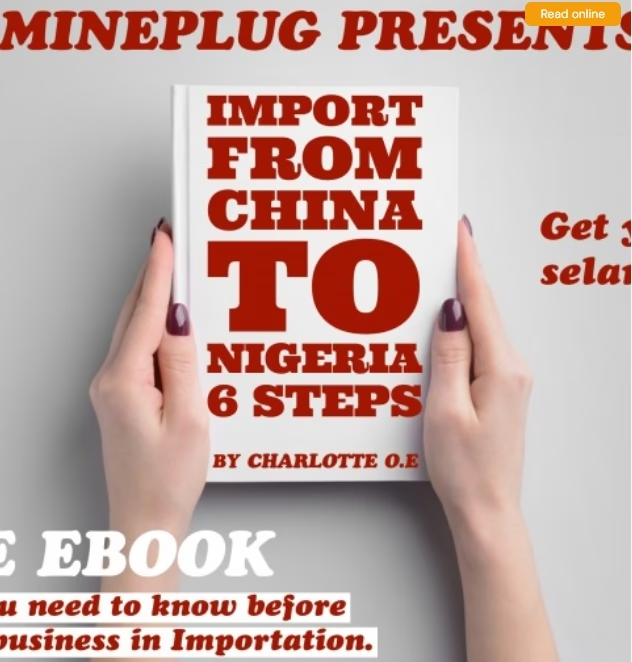Importing goods from China can be a highly profitable venture, given its extensive manufacturing capabilities, competitive pricing, and vast supply chain networks. However, the process involves intricate steps, from meticulous product selection and reliable supplier identification to navigating complex customs regulations and managing international logistics. This guide provides a comprehensive overview, emphasizing key strategies and resources to ensure a smooth and successful import experience.
Essential Insights for Successful China Imports
Strategic Supplier Sourcing: Identifying and verifying trustworthy manufacturers or suppliers is paramount, often facilitated by dedicated sourcing agents to ensure quality and reliability.
Navigating Customs and Tariffs: Understanding and complying with the ever-evolving import regulations, documentation requirements, and tariff structures in both China and the destination country is critical for avoiding delays and unexpected costs.
Optimizing Logistics and Documentation: Efficient shipping methods, proper preparation of essential documents like commercial invoices and bills of lading, and diligent customs clearance procedures are vital for timely and compliant delivery.
The Comprehensive Journey of Importing from China
The import process from China is a multi-faceted endeavor that requires careful planning and execution. It spans various stages, each with its own set of challenges and considerations. By methodically addressing each step, importers can significantly mitigate risks and enhance their chances of success.
Step 1: Strategic Product Selection and Market Analysis
Before initiating any import activities, it’s crucial to identify products that resonate with market demand and offer healthy profit margins. This involves thorough market research to pinpoint lucrative niches and trending items. Understanding consumer needs and competitive landscapes will inform your product choices and sourcing strategy.
Step 2: Identifying and Vetting Reliable Suppliers
Finding a trustworthy supplier or manufacturer is arguably the most critical step. Platforms like Alibaba, Global Sources, and Yiwu Market serve as starting points. However, for enhanced security and expertise, many importers opt to work with a dedicated China sourcing agent. These agents specialize in:
Verifying Supplier Credentials and Ensuring Quality
- Conducting due diligence on potential suppliers, checking certifications, trade history, and customer reviews.
- Arranging factory audits to assess production capabilities and quality control processes.
- Facilitating the examination of product samples to verify quality and adherence to specifications before placing large orders.
Negotiating Terms and Managing Communication
- Assisting in price negotiations, minimum order quantities (MOQs), payment terms, and delivery schedules to secure favorable agreements.
- Bridging communication gaps and ensuring clear understanding between the importer and the Chinese supplier.
Using a sourcing agent, such as those found through the Best Sourcing Agent website, can significantly streamline this process, especially for new importers or e-commerce sellers.
Step 3: Preparing Essential Documentation
Accurate and complete documentation is crucial for smooth customs clearance and avoiding delays. Key documents typically required include:
- Commercial Invoice: Details the goods, their value, and terms of sale.
- Packing List: Provides information on the contents of each package, including dimensions and weight.
- Bill of Lading (B/L): A contract between the shipper and the carrier, serving as a receipt for freight services. For sea shipments, an Import Security Filing (ISF) is also often required.
- Certificate of Origin: Verifies the country where the goods were manufactured.
- Customs Bond: A financial guarantee ensuring that duties, taxes, and fees are paid to customs.
Importers or exporters must often register with the China Customs system to obtain a filing record number, which is necessary for transactions.
Step 4: Arranging Shipping and Logistics
Selecting the appropriate shipping method depends on factors like urgency, volume, and cost. Sea freight is generally the most cost-effective for large quantities, while air freight offers faster delivery for smaller or time-sensitive shipments. Partnering with reliable freight forwarders or logistics companies is essential. Understanding Incoterms (International Commercial Terms) like FOB (Free on Board) or CIF (Cost, Insurance, Freight) is vital, as they define the responsibilities and costs between the buyer and seller at different stages of the shipping process.
Step 5: Navigating Customs Clearance and Tariffs
Customs clearance is a critical phase where imported goods are processed through the customs authority of the destination country. This involves submitting declaration forms, ensuring compliance with import regulations, and paying applicable duties and taxes. Tariffs, especially between the U.S. and China, can significantly impact the overall cost of imports. For example, as of July 2025, the average U.S. tariff on Chinese goods is approximately 51.1 percent, and these can be complex and stacked with additional duties like Section 301 tariffs. Using a customs broker can greatly simplify this process, as they specialize in navigating the complex procedures and ensuring compliance.
Understanding Tariff Structures
Import duties and taxes are calculated based on various factors, including the type of product, its value, and the country of origin. Staying updated on current tariff rates and policies is crucial for accurate cost estimation. Tools like China Customs Duty Calculators can help estimate these costs.
The Role of a Customs Broker
A customs broker acts as an intermediary, handling all the necessary paperwork, communicating with customs officials, and ensuring that all regulations are met. This includes classifying goods correctly, calculating duties, and facilitating the release of shipments.
Step 6: Payment and Post-Arrival Procedures
Once the shipment arrives and clears customs, the final steps involve making the payment to your supplier (if not already done) and arranging for the pick-up and inspection of the goods. It is paramount to thoroughly inspect the received products for any damages or discrepancies immediately upon arrival. Any issues should be promptly communicated to the supplier or sourcing agent for resolution.
Here’s an illustrative mindmap detailing the key components of the importing process from China:
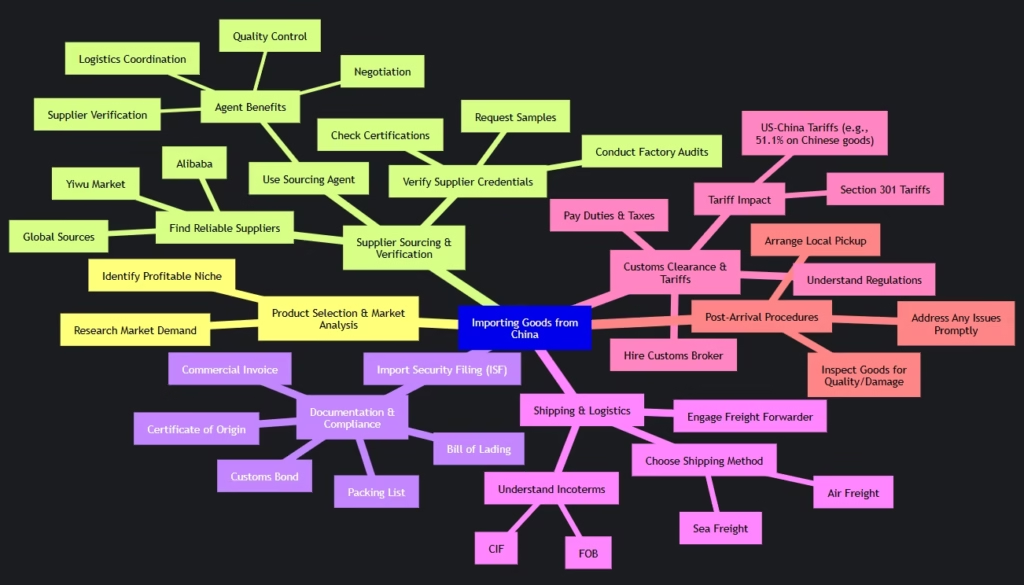
This mindmap visually represents the interconnectedness of each stage, highlighting the comprehensive nature of importing from China.
The Indispensable Role of a Sourcing Agent
While importing directly is possible, especially for experienced importers or simpler products, leveraging a China sourcing agent significantly streamlines the process and mitigates risks. Sourcing agents provide invaluable services that extend beyond merely finding suppliers.
Why Consider a Sourcing Agent?
- Expertise and Network: Agents possess deep knowledge of the Chinese market, local regulations, and extensive networks of verified suppliers.
- Quality Assurance: They can conduct rigorous quality checks, factory audits, and pre-shipment inspections, ensuring products meet desired standards.
- Cost Efficiency: Through skilled negotiation and consolidation of goods from multiple factories, agents can often secure better pricing and reduce overall logistics costs.
- Risk Mitigation: They help identify and avoid scams, resolve disputes, and ensure compliance with international trade laws.
- Communication Facilitation: Overcoming language barriers and cultural differences, agents ensure clear and effective communication throughout the transaction.
Websites like best-sourcing-agent.com serve as valuable resources for finding reputable agents who offer end-to-end support, from product development to logistics and customs clearance. This can be particularly beneficial for businesses entering the import market for the first time or those with limited resources for direct management.
Understanding Key Import Cost Components
Importing involves various costs beyond just the product’s purchase price. A clear understanding of these expenses is essential for accurate budgeting and pricing strategies.
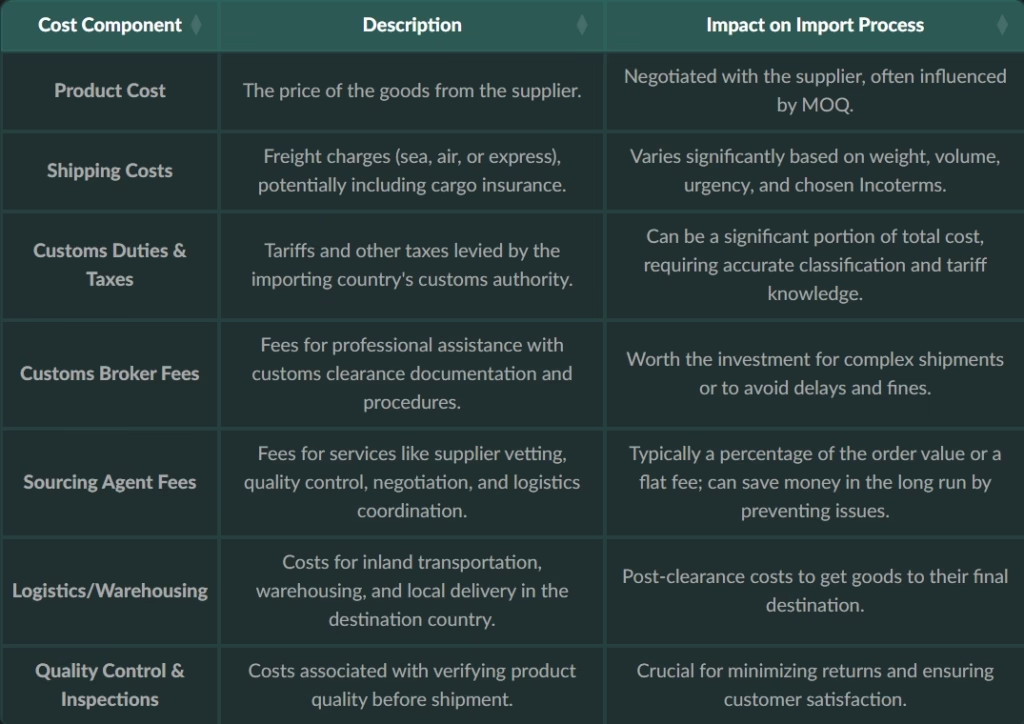
This table summarizes the primary financial considerations when planning an import operation from China, emphasizing how each element contributes to the overall landed cost of goods.
Comparative Analysis of Import Aspects
To further illustrate the nuances of importing, let’s look at a comparative analysis of different aspects, scaled to show their perceived complexity and importance based on general import experiences.
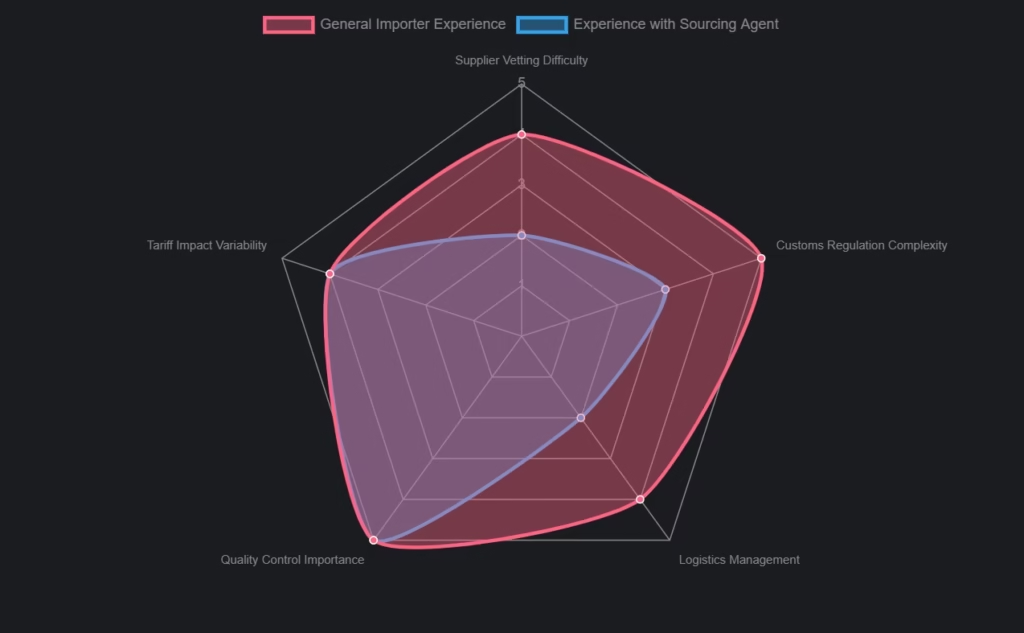
The radar chart above visualizes the perceived difficulty and importance of various aspects of importing from China, contrasting a general importer’s experience with that of an importer utilizing a sourcing agent. A lower score indicates less difficulty or lower variability, while a higher score signifies greater complexity or importance. It highlights how a sourcing agent can significantly reduce the difficulty associated with supplier vetting and logistics management, while the importance of quality control and tariff variability remain consistently high.
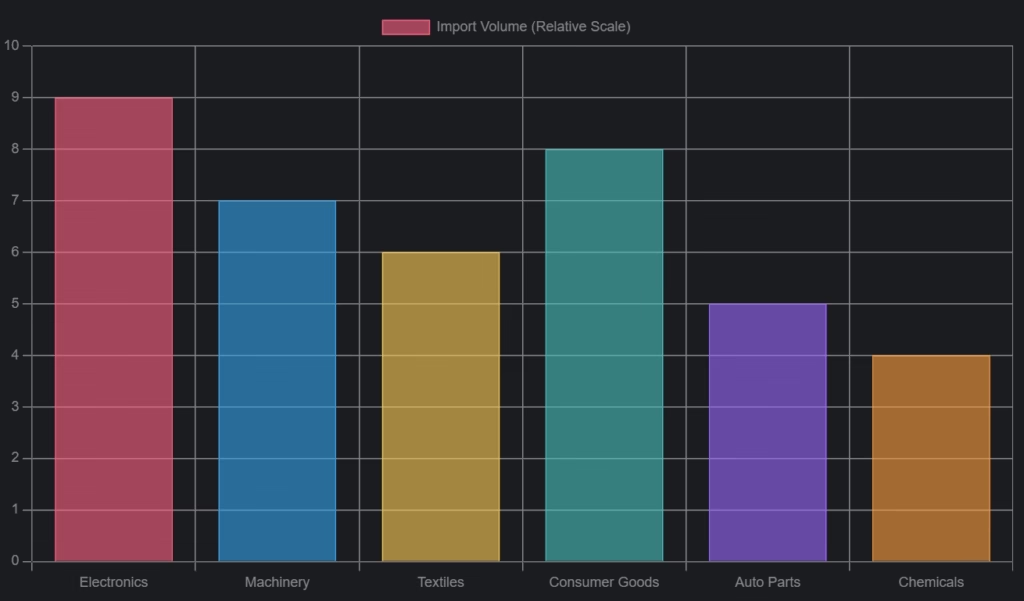
This bar chart illustrates the relative import volume of various product categories from China. Electronics and consumer goods consistently show high import volumes, reflecting China’s strong manufacturing base in these sectors. Machinery and textiles also represent significant categories, while more specialized items like auto parts and chemicals show comparatively lower volumes in general trade. This chart provides a snapshot of popular import sectors, helping potential importers identify areas of high demand and established supply chains.
Frequently Asked Questions About Importing from China
1.What are the most common challenges when importing from China?
Common challenges include identifying reliable suppliers, ensuring product quality control, navigating complex customs regulations and tariffs, managing logistics efficiently, and overcoming communication barriers.
2.How important is a customs bond for importing goods?
Common challenges include identifying reliable suppliers, ensuring product quality control, navigating complex customs regulations and tariffs, managing logistics efficiently, and overcoming communication barriers
3.Can I import from China without a sourcing agent?
Yes, it is possible, particularly for experienced importers or those dealing with simpler, well-established products. However, a sourcing agent is highly recommended for new importers, complex products, or when aiming to mitigate risks and streamline the process.
4.What are the typical payment methods for Chinese suppliers?
Common payment methods include wire transfers (T/T), Letters of Credit (L/C) for larger transactions, and sometimes online payment platforms like PayPal for smaller orders. Negotiating favorable payment terms, such as a deposit followed by balance payment upon shipment or delivery, is crucial.
5.How do tariffs impact the cost of importing from China?
Tariffs, such as those imposed by the U.S. on Chinese goods, can significantly increase the landed cost of products. They are calculated as a percentage of the product’s value and can be complex, sometimes involving stacked duties. Importers must factor these into their pricing strategies.
Conclusion: Mastering the Art of Chinese Imports
Importing goods from China is a strategic business decision that, while complex, offers immense opportunities for growth and profitability. Success hinges on a methodical approach, starting with careful product selection and market analysis, followed by diligent supplier vetting. The importance of preparing accurate documentation, understanding customs regulations, and efficiently managing logistics cannot be overstated. For many, engaging a reputable sourcing agent proves to be an invaluable asset, simplifying intricate processes, mitigating risks, and ultimately contributing to a smoother, more cost-effective import journey. By mastering these key aspects, businesses can effectively tap into China’s vast manufacturing capabilities and deliver high-quality products to their target markets.

